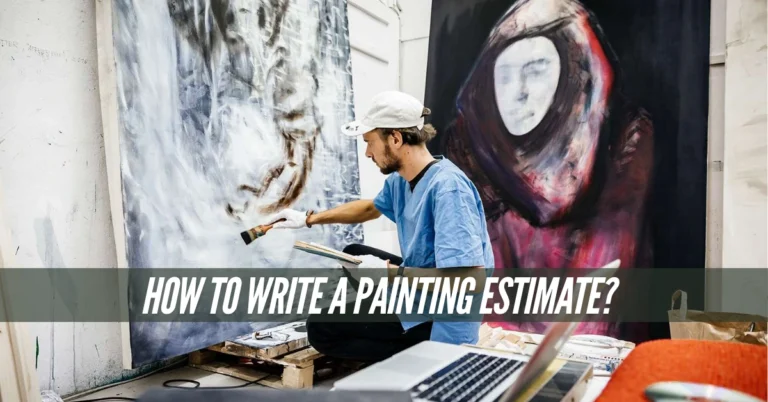How to Become a Painting Contractor?
Becoming a painting contractor offers an exciting and fulfilling career for anybody with craftsmanship skills, a desire for detail, and a passion for working to promote their talent. The painting industry offers the opportunity to work in any residential or commercial sphere. You can focus on the types of painting industry that interest you the most. However, succeeding in this industry goes far beyond painting walls. It requires understanding the full business scope, including painting estimation. Ready to learn how to become a painting contractor? Let’s get started!
Painting Contractor
A painting contractor provides services for domestic, commercial, and industrial clients. He oversees and completes painting jobs within or outside of buildings. His work involves everything from preparing the surfaces to selecting suitable materials, ensuring that the work meets safety standards, and managing a team of painters.

Getting the Right Experience
Gaining experience in the painting field is essential before starting your own business in the painting trade. While it’s possible to start from scratch, learning the basics and refining your skills through hands-on experience is highly recommended. This on-the-job training helps you master essential skills like surface preparation, applying various coatings, and using different painting tools and equipment.
Start as An Assistant or Apprentice: Many painting companies or contractors are open to hiring apprentices who want to learn the trade. This is an excellent way to get paid while you learn.
Practice Different Techniques: Learn to handle residential and commercial projects, working with everything from basic interior wall painting to intricate exterior finishes.
Work on Various Surfaces: Practices painting on different materials such as drywall, wood, metal, and concrete to understand how each surface requires different treatment.
Get Certified and Licensed
To legally operate as a painting contractor in your region, you must get the relevant licenses and permits. Requirements vary by district, so you must check with local government offices-the city or state’s contractor licensing board to ensure you follow the correct procedures.
Business License: If you are opening up your own painting company, you must register your business with the local authorities to be issued a business license. This will help you operate lawfully and take care of taxes.
Permit: Some jurisdictions require painting contractors to apply for a permit. This may mean demonstrating experience or passing an exam on business management, building codes, and safety standards.
Lead-Safe Certifications: If you work in older houses than those built in 1978, you may need lead-safe certification from the EPA, since many homes of this age still contain lead-based paints. Assures proper practices in dealing with materials of this nature.
Insurance and Bonding: Contractors would need liability insurance coverage in case of accidents or damages to other people’s properties. Bonding would protect clients’ interests if the job still needs to be finished according to agreement.
Developing a Business Plan
You now attain experience and the necessary certifications. It’s time to start implementing your business plan. A business plan is crucial to the operation of a successful painting business and will help guide you through the startup phase and even after it’s established.
Service Offering: Determine if you want to target residential, commercial, or industrial painting. You may also specialize in faux finishes, wallpapering, and pressure washing.
Target Market: Identify your target market, such as home remodels, new construction, or large corporate buildings. This can specify the nature of your marketing approach.
Financial Plan: Start by calculating the cost to start and run a business, including insurance, tools, and vehicle expenses. Create a pricing model for your services, whether you charge by the hour or by the job. Be sure to factor in all costs when setting your rates.
Marketing Strategies: Then, plan how you will attract customers. Word of mouth can help out significantly in such a business; however, you may also rely on advertising online, social media or even partner with other contractors or interior designers.
Establish Your Business
With your plan in hand, it is time for you to get into your business. This will include business registration, insurance coverage, and other necessary tools and equipment. Starting a professional company will help you handle projects professionally and stand tall before clients.
Register Your Business: Identify a name that will define your business and service and attract your potential clients. Identify the proper legal structure and file to register as an owner under a sole proprietorship, a partnership, or an LLC.
Business Insurance: You’ll need to get liability insurance for your business. This will at least cover general liability, workers’ compensation if you have employees, and bonding if you want to assure your clients of the integrity of your work.
Invest in Tools and Equipment: You will need various tools, such as brushes, rollers, sprayers, ladders, scaffolding, and safety gear. A truck or van is also necessary for more extensive jobs to haul your tools and supplies.
Pricing Your Service: Pricing your service: When calculating your markup, consider essential factors like your expertise, the complexity of the project, the materials required, and the time involved. Conduct market research to understand local pricing trends and align your rates accordingly.
Presenting a detailed painting cost overview ensures transparency and helps clients appreciate the value of your services, increasing your chances of securing the job.
Market Your Painting Service
Marketing is basically the collection of a robust client base. You might already have a few contacts in the industry or through your own network, but you will have to grow and reach a larger audience to take your business further.
Word of Mouth and Referrals: Do excellent quality work and provide service to your customers with excellence. Word-of-mouth referrals are always the most potent form of advertising for a painting business.
Make Your Online Presence: Create a website with your portfolio of past work, client testimonials, and contact details. Share before-and-after photos of your work on social media. You can use Yelp or Agni to get reviews and attract local clients.
Local Advertising: Local marketing is real. Distribute flyers in your neighborhood, advertise in local newspapers, and place business cards at local businesses. A branded truck or van is also an excellent way to advertise on the job.
Networking: Contact others in the industry, such as builders, real estate agents, or interior designers, who can refer clients to you.
Concentrate on Customer Satisfaction and Quality
Customer satisfaction is the secret to any successful operation as a painting contractor. Satisfied customers tend to refer business your way and also give you repeat business.
Effective Communication: Communicate with your client regarding the progress of the job, the delays, and the costs incurred. Keeping clients informed about the project’s progress, addressing delay issues proactively, and sharing transparent cost details with reliable painting quote preparation will make things clear and trustworthy.
Professionalism: Be punctual, respectful, and courteous at all times. When you’re professional with your clients, you establish confidence and trust.
Quality Control: Before closing up a job, inspect the work to ensure it meets your high standards. Take some time to touch up areas of attention.

Conclusion
Being a painting contractor is a rewarding experience, but also a delicate blend of technical skills and business acumen. It builds reputation through on-the-job experience, proper certification, and careful planning in putting together your business. Whether a small residential house or a huge commercial building, it all boils down to providing quality work and taking good care of that client, growing in skill and business.



